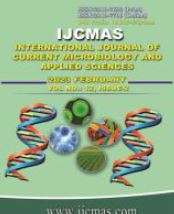


 National Academy of Agricultural Sciences (NAAS)
National Academy of Agricultural Sciences (NAAS)

|
PRINT ISSN : 2319-7692
Online ISSN : 2319-7706 Issues : 12 per year Publisher : Excellent Publishers Email : editorijcmas@gmail.com / submit@ijcmas.com Editor-in-chief: Dr.M.Prakash Index Copernicus ICV 2018: 95.39 NAAS RATING 2020: 5.38 |
Background: Candida species are the fourth most common cause of bloodstream infections in USA whereas rank eighth in India. There is a progressive shift from a predominance of Candida albicans toward non-albicans candida (NAC) spp., especially C. tropicalis, C. parapsilosis and C. glabrata. The present study is undertaken to know the various risk factors, recovery of candida species and their susceptibility pattern in patients admitted in a tertiary care hospital. Material and methods: The paired blood culture samples were processed in The BacT/ALERT 3D Blood Culture System. The automated system used was Vitek-2 with YST-ID cards. The antifungal susceptibility testing of Candida isolates were done for fluconazole, voriconazole, amphotericin B, caspofungin and micafungin by using AST-YS07/08 card. Result: A total of 71 (5.70%) patients were included in the study. The various Candida spp isolated were 31 (43.66%) C. tropicalis followed by 19 (26.76%) C. auris, 9 (12.67%) C. albicans, 7 (9.85%) C. parapsilosis, 4 (5.63%) C. glabrata, 1 (1.40%) C. guilliermondii. The present study showed non-albicans Candida species isolates had higher azoles MIC values than C. albicans isolates. Conclusion: The changing epidemiology of candidemia highlights the need for close monitoring of Candida species distribution and susceptibility to optimize treatment and outcome. Resistance to antifungals is gradually increasing, and thus, there is an urgent need for antibiotic stewardship, maintaining aseptic techniques and better hand hygiene practices.
 |
 |
 |
 |
 |